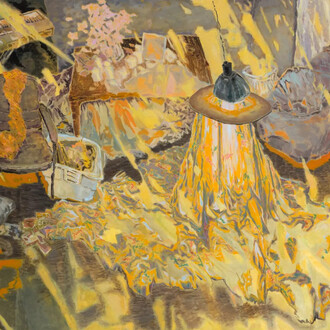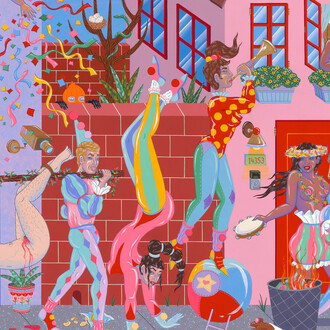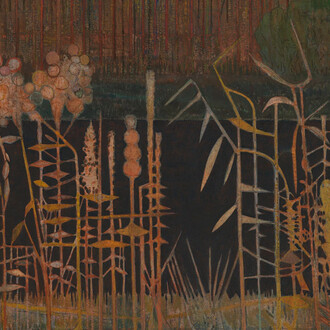Baert Gallery is pleased to present “Color is an act of reason,” a group exhibition featuring Jasmin Blasco, Melinda Braathen, Francesca Gabbiani, Reuben Gordon, Amy Mackay, Iliodora Margellos and Jebila Okongwu. The show as a whole is evocative of the luminous world of Bonnard. The title “Color is an act of reason” is pulled from the artist himself, who often utilized color as a response to the psychological nature of his work.
Much like Bonnard’s work, the driving force of color unifies the exhibition. Although intensely personalized in regards to aesthetics, all artists experiment assiduously with color—a unifying linchpin in a celebration of chromatic expression. Color is apparent in each artist’s versatile applications, evoking memories of past intertwined with present. Apart from the obvious emphasis on a spectrum of vibrant hues, this show engages one through various shapes, rhythms and emotions. Together the artists’ use of vivid evocative colors captures moments in time, creating portals into other worlds and inviting us to see spectrums otherwise lost.
Avery Wheless, Los Angeles, August 2019
Jasmin Blasco (b. 1981 Paris, France) is a French-American artist who works with sound, language, film, installation and performance. His practice explores the relationship between interpretation, translation and narration. Blasco’s work pays particular attention to the evolving dialog between communication systems and their embodiment, observing the ways in which narratives emerge out of the encounter between the lived experience and the built environment.
Melinda Braathen (b. 1985 Oslo, Norway), explores perception and light through paintings. Her works blend figuration and abstraction in an effort to express how dependent our perception is on physiology. Braathen’s process often begins with accurately representing the figure within her environment, only to gradually obliterate, conceal or dissolve it into a series of abstract forms. In several instances, what remains is an artistic interpretation of an individual’s internal psychology, in an effort to render visible every day rhythms and sensations arising inside the body, as well as subtle external forces exerted on the body.
Francesca Gabbiani (b. 1965 Montreal, Canada) creates cut-outs that require extensive amounts of time, technical organization, a well thought-out visualization of each work, and the built-in potential to incorporate in each piece the eventual spontaneous events that determine its final creation. Gabbiani’s method is unforgiving; the piece is finalized after days, weeks and months of work. From the initial drawing (or photograph), Gabbiani constructs the image layer after layer, relying on strata of fastidiously cut archival paper, rather than the rules of perspective.
Reuben Gordon (b. 1996 New York, NY) is most interested in color, and formal qualities of painting. Concepts, emotions and meanings follow, through them. Gordon’s current work mainly consists of interior figurative scenes and exterior cityscapes, set where he was born and raised in Manhattan’s Lower East Side, and Brooklyn. His depictions, of friends and places he is in close, intimate relationships with, are filled with humor and existential longing.
Amy Mackay (b. 1985 Sonoma, CA) explores issues of group memory, mediation and time. Her process follows a rhizomatic structure of recall. Each body of work relies on the construction of a group experience that is made to be remembered: like two brackets that create an empty space in-between, painting becomes a shared origin and destination. Through iterations of research, staging and translation, image and performance chase after each other, and on and on. It is a sequence both embodied and imaginary, a sequence of regeneration.
Iliodora Margellos (b. 1985 Minneapolis, MN) focuses on drawing, sculpture, painting and installation. She alternates between structures, materials and scale, thus vacillating between figuration and abstraction as a form of investigation, even though she probes the same questions: solitude, anger, anxiety, patience and human interaction.
Jebila Okongwu (b. 1975 London, United Kingdom) critiques stereotypes of Africa and African identity and repurposes them as counterstrategies, drawing on African history, symbolism and spirituality. One of his preferred materials is banana boxes; their tropicalized graphics articulate an ‘exotic’ provenance, much like the exoticization of African bodies from an ethnocentric perspective. When these boxes are shipped to the West from Africa, the Caribbean and South America, old routes of slavery are retraced, accentuating existing patterns of migration, trade, and exploitation.
















